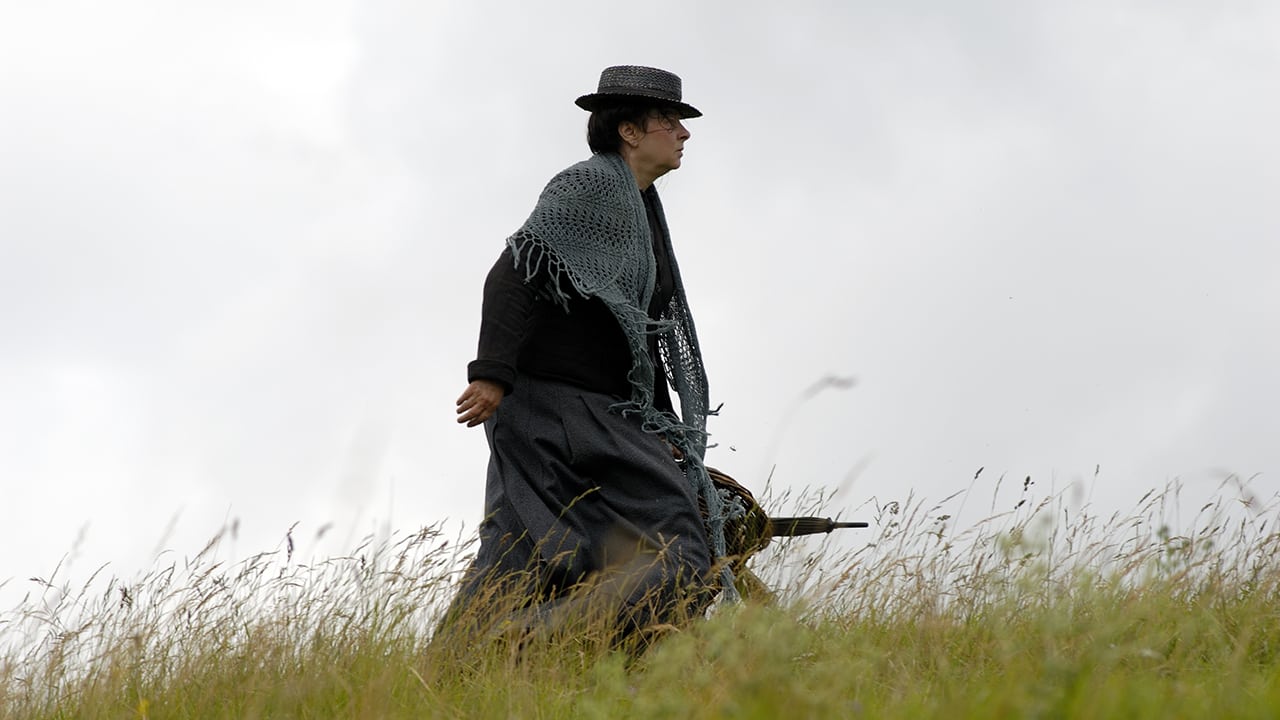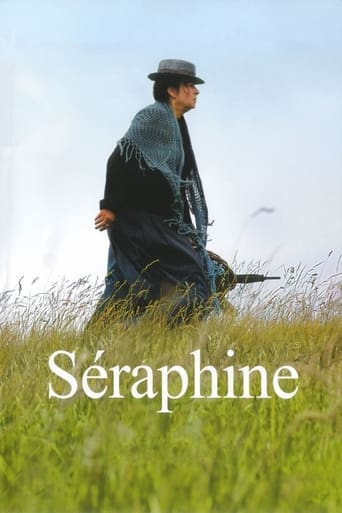



Let's be realistic.
Absolutely brilliant
Story: It's very simple but honestly that is fine.
One of the film's great tricks is that, for a time, you think it will go down a rabbit hole of unrealistic glorification.
View MoreSpeaking as someone who would rather have my teeth pulled out individually and slowly than be forced to watch Hollywood product of any kind Séraphine wasn't so bad - at least I watched it to the end. But I've lived in France for many years and seen hundreds of French films and there are many like this one. The main objection is that "cultural" French films like this are quite a bit less than the sum of their parts: they are "full of themselves" with an idea that it's sort of "cool" to be understated, not to tell a story, but just to depict a slice of life, albeit of an extraordinary person in a period setting, and say "now, look at that...", and we're meant to go "hmm... fulfilling". So often I'm afraid this is film-making about film-making. There were things to be asked here, which might have been useful to know but which would have (horror, how uncool!) involved exploring character a bit more - particularly of Uhde: why was there a gap of 14 years between his departure from Senlis and his decision to go back and rediscover his protégée? - perhaps a little more cynicism generally about the motivations, passions and prejudices and art dealers, who are obviously flawed individuals like the rest of us, would have made for a much more engaging film. But it would not have "complied" with the mandatory "film d'art et de contemplation" aesthetic.
View MoreThis is the story of the French artist Séraphine Louis, posthumously known as "Séraphine de Senlis" (Senlis being her home town). Séraphine lived from 1864 to 1942 and is remembered primarily for the work she produced in the 1920s.Séraphine is first seen here as a house-cleaner and servant who performs menial tasks. She pretty much keeps her own company, although she does break bread on occasion with some local nuns at a convent where she was once a domestic. Rather plain in appearance and dress, and of sizable frame, she garners little notice and is treated with disregard, or outright insolence, by her employers. But Séraphine has an obsessive passion, which is to paint. She makes do with pigments she can come by for free like blood, candle wax, and certain soils; for those items she needs to buy she forgoes spending money on most everything else, like food and paying rent. This is her life until Wilhelm Uhde, a German art critic she tends to, accidentally sees one of her early paintings and is taken with it. But public recognition of Séraphine's talent is not immediate, being interrupted by World War I. What happens to Séraphine later in life after achieving some success is rather sad and augments the myth of the connection between madness and art.One aspect of Séraphine's personality that I found most interesting was the connection between her religious faith and her art. She felt that her guardian angel had commanded her to paint. While practicing her art, she would often sing songs of religious praise. Religious inspiration seems to be a source for a lot of great art.Yolande Moreau is perfectly cast as Séraphine; she gives a very believable performance. Her early life is that of a starving artist, however her physical appearance does not much reflect that she is starving. The period details (early twentieth century) are well done.The photos of some of Séraphine's works on one of the DVD extras are not to be missed. I feel that I got a much deeper understanding of the woman by having seen those. The paintings are uniquely beautiful; the level of detail is stunning and attests to her obsessions. Seeing these after the movie was kind of like seeing a fireworks display after a concert or sporting event.
View MoreCinema is a language of deception. The set we see, the mise-en-scene, is what the director wants us to see. Conditioning us visually before an actor even speaks their lines. In costume dramas, the historical clothing is a further weapon to impress a specific artistic vision on us, further cloaking any subtext, whether the transformation of a marriage market story into 'rom-com' (Pride & Prejudice) or consciously travestying the past (Moulin Rouge!, Marie Antoinette). French cinema has achieved respected and less controversial use of costume with films like Jean de Florette and Manon des sources. In these examples, beautiful, nostalgic settings were contrasted with dystopian visions of the hard life. When we move to the biopic, cinematic techniques are routinely used to persuade us of 'what really happened.' Séraphine continues the proud French tradition of costume and historical drama, yet in a very accessible vein. It tells the (true) story of a minor French painter, Séraphine Louis (later known as Séraphine de Senlis, after the village where she lived.) Our story picks up Séraphine working as a maid for Madame Duphot. This lady of the house also rents an apartment to a German art critic-dealer, Wilhelm Uhde. Uhde believes in the 'primitive' artists and takes a liking to some of the maid's work he spots. Yolande Moreau's assured performance gives weight to what may be an unvarnished account. The discovery of the peasant woman's talent, her humble charm as she goes about collecting the ingredients for paint (wine, mud, fruits, flowers) as she goes about her chores as a domestic servant. Everything draws us sympathetically into Séraphine's world.Udhe nurtures Séraphine's embryonic talent, ensuring it is seen worldwide. But as war hits the economy, support evaporates. Séraphine's inner voices of inspiration lead her to psychosis and she meets her demise in an insane asylum.The painting itself is of the so-called 'naïve' style, characterized by childlike simplicity. (One of the most famous exponents, according to some, is L. S. Lowry.) The style seems natural to the childlike (if brilliant) personality of our peasant woman, although of course many naive art painters, including Lowry had, unlike Séraphine, plenty of schooling and formal knowledge of art technique.Production values in the film are high all round. Costume, acting, direction, all achieve a high standard, as evidenced by the many awards heaped on it in its own country. The overall effect is touching without being sentimental.Séraphine is a continuation of one woman's barely recognised legacy. Any subtext is about serving up a fine character from France's past, a commemoration of national greatness from the early 20th century. (Visits to the exhibition of her work in Senlis have, predictably, quadrupled since the release of the film.) If there is any ideological weakness, it is simply that held by the character herself, a Christian attitude of sacrifice and acceptance of fate. There is no strong judgement on whether Séraphine could have lived her life differently. No real analysis of her painting style. It is, after all, a classy and enchanting fairy tale hung on the hook of a historical person, a harmless deception perhaps. The viewer, should she or he wish, can make their own judgement. Just as they can on the deeply religious and fairly distinctive artworks she left for posterity.
View MoreSeraphine Louis,who would eventually change her name to Seraphine deSenlis (after the name of her hometown)was an artist who cleaned houses by day,and painted by night (all the time while singing the hymns of her staunch Catholic upbringing,while she was growing up an orphan by Nuns). Seraphine is pretty much maligned by the village locals,taunted by children,and pretty much avoided by most all that know her. When German art collector & critic,Wilhelm Uhde rents a room in the town of Senlis,while on the run from the insanity of World War I,and discovers a painting by Seraphine & is amazed by it's use of colour & texture. When the war moves ever closer,Uhde & his sister escapes the madness. Years later,he returns to Senlis,rediscovers an aged,but still painting Seraphine & vows to put her work on display (despite the fallout of the Wall Street crash of 1929,as well as the subsequent great depression,that managed to cripple a good percentage of Europe's economy,as well). Martin Provost directs & co writes (with Marc Abdelnoir)a lovingly depicted portrait of a woman possessed of genius that is cruelly stolen too early (deSenlis spent her aged years in an insane asylum & never painted again in life). Yolande Moreau plays Seraphine,a woman unpossesed by pretentious,real fine. Ulrich Tukur plays Wilhelm Uhde,in a winning role that depicts Uhde as an impresario of art first,and who's personal life is down played,somewhat (in life,Uhde was an ardent homosexual that made no bones about his gay lifestyle). The photography is a real treat for the eye (at times,the composition of visual images are very painterly,such as films such as 'Tous Le Matin Du Monde'). A film to check out for those with a love of art,or art history (or both). Spoken in French & German with English subtitles. Not rated by the MPAA,this film contains flashes of nudity & adult content.
View More